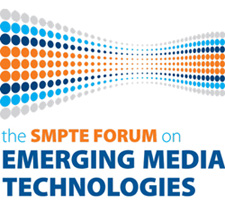SMPTE’s Crystal Ball
Editor’s Note: The SMPTE Forum on Emerging Media Technologies takes place May 13 - 15 in Geneva, held in collaboration with the EBU. TVT Europe asked some of the forum’s participants where the media industry be in the next 10 to 15 years, and what should organizations be doing now to prepare for success in the future?

Leonardo Chiariglion -- CEO, of CEDEO and Founder, ISO/IEC Moving Pictures Experts Group (MPEG)
Today the media industry is already shaped by the plurality of systems employed for delivery of content. For a given type of content, usually there is a primary delivery system; typically inherited by the media company from another age. That main delivery system is more and more supplemented by other systems that serve the purpose of making available the same or modified content with different features (resolution, on demand, pay, and interactive).
In 10-15 years, more delivery systems will appear further decreasing the effect of this cultural legacy. Content will be prepared for distribution based on its features and delivered over the systems that will be more convenient for the specific features.
Media companies should just continue their work, but with a mindset geared toward the expected outcome and a constant ability to fine tune their behavior based on the signals coming from the market.
A second area of attention is the constant appearance of new media technologies enhancing and extending the user experience. An example of the former are higher resolution pictures made possible by new presentation devices and new compression standards; an example of the latter are full-blown 3D pictures that will offer new experiences blending synthetic and natural content. Media companies should tread a fine line balancing actual experience of new technology without over-investing in any.

John CS Yip -- Chief Engineer, Radio Television Hong Kong
The media industry, being propelled by fast advances in technologies (the nano-transistors are in the labs), is somewhat unpredictable. But there are some trends; such as the big global players setting off tsunamis, changing consumer habits due to enhanced mobility and multiple platforms, and businesses looking for new opportunities but facing increased risks. One could say that the future media world is more “immersive,” exciting, wide-ranging, accessible and sophisticated for consumers. The evidence is abundant. You only need to look around see the impact of YouTube, smartphones, and tablets.
The trajectory of the industry in moving to the new media world is not a single curve, but rather multiple ones; global, regional, and local. Each curve is the composite result of various factors, as embodied in the RPMO model explained on various occasions.
As for finding the way forward, consumer habits should be the primary focus. After all, the money is in their pockets. Organizations need to focus more on their core competencies, in the increasingly competitive environment. They need to understand more about media and technological developments as well as subtle changes in consumer habits; analyze more regarding ROI, RPMO, and other measures for sound business modelling.
They should take advantage of unique business opportunities; riding on the huge energy waves of the big players and experimenting at affordable costs; and risk more – but in a calculated fashion. Media organizations also need to adopt future-proofing capital investment strategies.

Martin Guillaume -- IBM Global Business Services Leader for Media - UK & Ireland
The media industry will be where its audience takes it – and this audience will be increasingly fragmented and demanding. Fragmented because what people want -- when, where and how they experience content -- will be more diverse and granular across age and social groupings. Demanding because “consumers” will replace “audiences.” Consumers will look for interesting, personalized, immersive experiences, rather than just asking “What’s on?” They will ditch technology and content providers who lock them into silos that mandate specific devices or apps to access.
Today, catch-up TV is ubiquitous and people multi-task rather than watch attentively.
Motion-sensor games consoles are being used for applications that go far beyond interactive games: You can now scan your body and have your avatar try on the latest fashions for you. As immersive and personal as the experience might get, it will continue to be consumers who drive how technology is used to define new media experiences.
Organizations should establish a relationship with consumers as individuals – encourage them to trust you and share with you. Focus as much on technology to understand what they think and feel as (on) creating and distributing content.
While content is the core of what you provide, think end-to-end, immersive and multi-channel now. Make the experiences compelling for your consumers, from the moment they engage with you through a smartphone app or a gesture at the TV. Understand your content better – analyze video to collect metadata at the frame level, so you can deliver tailored content to match your consumers’ tastes and interests.

Alain Andreoli -- President & CEO, Grass Valley
A timeframe of 10-15 years is a very long way out; especially considering that many organizations are struggling to determine what the media landscape will look like in just three years, let alone five. So let's prognosticate a bit: The biggest change to the media will be in distribution. With improved compression and display technologies, no longer will the "alternative" viewing devices be limited by a small screen size only capable of low resolution and partial frame-rate video. All devices will get "television" the way we are accustomed to -- with full resolution and frame rate.
The industry will move beyond today’s battle between broadcast and broadband to a hybrid delivery model. It will enable access to the most popular content delivered by broadcast and broadband connections providing access to the rest, but that technical infrastructure will be invisible to the user.
Savvy content owners will realize that viewing on a portable device is a personal rather than a group experience, and that broadband and broadcast technologies can be combined to personalize content streams with targeted advertising. So, just like in 2012, in 10 or 15 years the main concern of the media industry will still be the desire to attract viewers, but developing technologies will provide new means to reach larger mobile audiences and new means to monetize the content.
How to move forward really depends on what the organization is. A traditional broadcaster needs to begin, if they haven't already, to determine how to cost-effectively convert and distribute content to a multitude of platforms – or screens, if you prefer -- as well as plan for channel growth with new services. Just as importantly, they need to explore the potential of mobile devices and new means of advertising that exploits the personal nature of that viewing environment, and the value provided by the bi-directional nature of many of those platforms.
INFO Program and registration information for The Forum is available at smpteforum.org. Regular updates are also available via Twitter at #smpteforum. A distribution/playout service also needs to deal with the world of multi-platform distribution to satisfy its customers. Both program producers and media rights holders will have to begin to negotiate in ways never even imagined just a few years ago, to adequately deal with the distribution and licensing issues of the future.
I would like to add that this is not just an evolutionary change in technology. It is not like adding pixels to a screen, or colour, or HD, or 3D. It fosters a humanistic dimension too. This change in the media industry is the foundation for a society-wide globalization; enabling access to diverse information and culture for all, everywhere, with amazing consequences on the way we will live in the future.
The “Broadcast” period (with its TV channels) has been a nation-centric happening. Now with the Internet, we are moving the video content across the world; enabling political events that were hard to imagine earlier. This is a new world ahead of us, with the emerging markets becoming its more vibrant catalyst. The media industry, through its metamorphosis, is becoming the enabler of a new emerging global culture.

Get the TV Tech Newsletter
The professional video industry's #1 source for news, trends and product and tech information. Sign up below.
